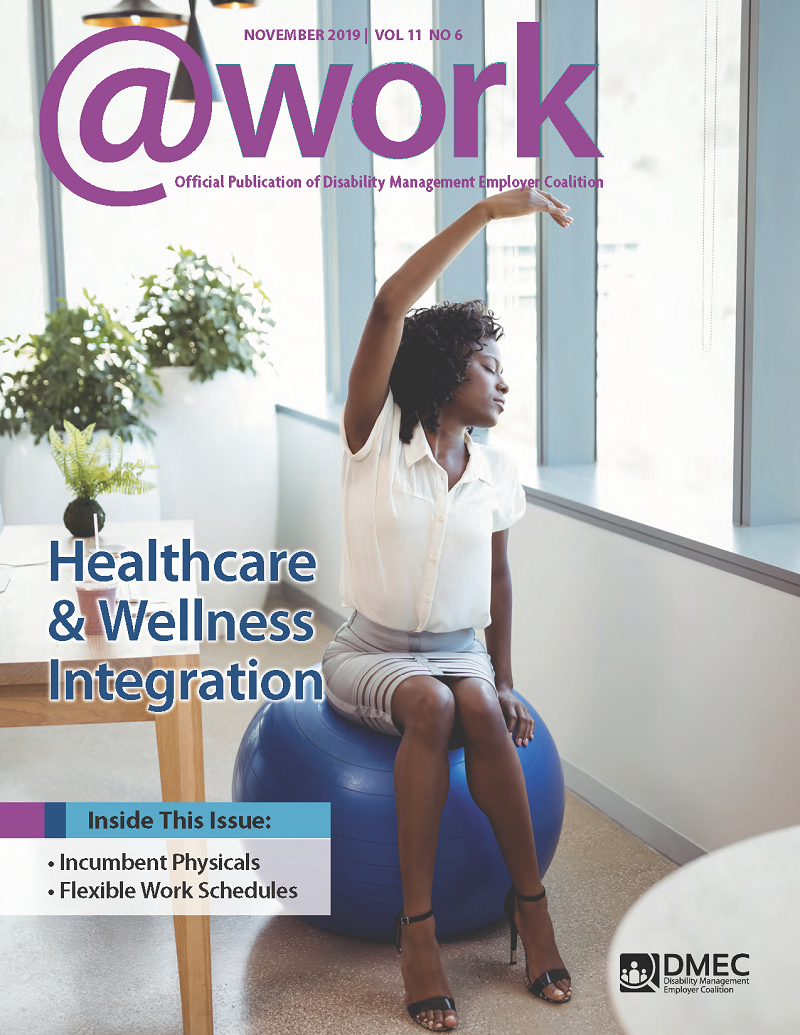
November 2019
Health & Wellness Integration
Employers are discovering that integrated health and wellness programs can increase overall employee well-being, improve workplace productivity, decrease absences, and reduce workplace injuries. This issue of @Work magazine shares case studies and best practices for physical ability tests, flexible work schedules, screening programs, and much more.
Features
Make Incumbent Physical Ability Tests Effective and Safe
Given the high-stress environment of the public safety profession, recruiting the next generation of public servants is more difficult than ever. Add on-the-job stressors and a highly physically & mentally demanding occupation, and total worker health can seem completely unattainable as a goal. Nevertheless, the city of Sioux Falls, South Dakota, has implemented a variety of strategies and tools to pursue that goal. Read more.

The Importance of Flexible Work Schedules in Absence Management
Millennials are challenging long-established workplace norms, and it’s turning out to be a good thing for the rest of us. With their clear preference for flexible work environments, and their willingness to leave if they don’t get what they want, Millennials are helping to drive change toward better work-life balance. Read more.

Spotlight Articles
Program Showcase: Screening/Early Intervention
Successful risk identification starts by casting a wide net. This means participation in a health-screening campaign by the majority of your insured population. You can do this by offering meaningful incentives through employee health benefit plans. Read more.

Compliance Showcase: Predictive Modeling
Employers recognize the benefit of maintaining a healthy employee population as a way to reduce absences, and they also recognize the cost associated with high-risk individuals. One tool for tackling this issue is analyzing population health trends and pairing employee health information from data warehouses with predictive modeling capabilities, leading to more early interventions. Read more.

Program Showcase: Caregiver Support
As the modern workforce changes, employers are evaluating the support they offer across the continuum of family caregiving. The dynamic nature of the workforce, along with ever-expanding regulated paid family leave laws, requires the employer to learn quickly. Read more.

Compliance Showcase: Mental Health Accommodations
In recent years, mental health conditions have increasingly contributed to disability-related absences. Both employers and employees will benefit from adopting a multi-pronged approach to create an open and supportive environment. It not only lessens the toll of mental illness, but also debunks stigmas that prevent employees from seeking help. Read more.

RTW Showcase: Guided Self-Care
Research has shown for decades that early intervention and a supportive employee experience are critical contributors to positive outcomes in workers’ compensation cases. This case study describes an innovative early intervention model that was applied in a workers' compensation plan. Read more.

Columns
Absence Matters: Wellness, Health, and Safety
Ongoing pain, high blood sugar, shortness of breath, restrictive movement, extreme fatigue, and stress responses are signs of underlying medical conditions. Employers are discovering that integrated health, wellness, and safety programs can combat these conditions, increase overall well-being, and improve workplace productivity. Read more.

Integrated Absence Management: Engaging Doctors
Physicians play a key role in work disability, but most are unprepared or unsupported to help their patients return to work. Employers and others can offer solutions that engage physicians to improve the employee health and disability experience. Read more.

Engaging Today’s Workforce: Faster RTW and Wellness
Particularly when an employee is on a leave, financial stress can exacerbate the illness or injury being managed. Employers can alleviate financial stressors with holistic benefits packages that include financial wellness tools paired with critical illness or accident insurance. Read more.

Employer Solutions: Leave Management Strategies
Today’s workforce is a snapshot of our nation at large. Generations mingle on a daily basis, one learning from the next and hopefully sharing the best of who we are. In recognizing the important contributions of each generation, employers can customize leave management programs. Read more.

FMLA Second and Third Opinions: Making Full Use
How long can the employer hold the employee to the second opinion results? The regulations are clear that the third opinion is “final and binding.” What does that mean? In practice, the employee can use a second or third opinion, as applicable, for the current leave year and potentially for future leave years, if any, as well. Read more.

The Disabled Workforce: Increase the Impact of Your EAP
If you expect to tackle the real killers of productivity, innovation, and retention, you must build a workforce that has the ability to successfully struggle through issues — both personal and professional — and that believes you care. As an employer, your EAP gives you a unique opportunity to provide both emotional support and get employees back on track at work. Read more.

Absence Minded: Addressing Presenteeism
Today’s employees have significant responsibilities on and off the job that impact their ability to focus on their work. What can an employer do about it? The issues come in a variety of shapes and sizes, and so do the answers. But there may be a central repository for many of the solutions: the employee assistance program. Read more.

Technology and Absence Management: Absence Data & Health Risk
Through a better understanding of the issues and risks affecting your employees, you can tailor your benefits plans to their needs, implement wellness programs that help where it matters, and explore other targeted interventions to create a happier, healthier, and more productive workforce. Read more.

Disability in the Workplace: Wellness Tune-Up Kit
When wellness programs are aligned with employee needs, they are more effective in reducing healthcare and absence costs and improving productivity. Here are some key considerations for your workplace wellness efforts. Read more.

Mental Health At Work: Mental Healthcare Services
When reviewing company-offered health benefits, a close look at the mental health services is warranted. Despite the fact that nearly one in five Americans will experience a mental illness in a given year, the related services through medical plans are typically difficult to access in a timely manner, may not be of high quality, and may not be legally compliant. Read more.

Aligning Workers' Compensation: Wellness and Safety
We have all heard the attacks on wellness programs in the media. Many of the attacks focus on return on investment (ROI), saying that wellness programs produce nominal ROI. Your wellness program may find an ally in an unexpected place: your organization’s safety program. Read more.

Departments
The CEO's Desk: A First Step in Wellness Programs
Most American adults are at risk in at least one adverse health risk category, and approximately half of them still don’t know it. Screening programs are key. We know that early intervention yields better health outcomes. Read more.

DMEC Special Feature
In a special feature, Marcia Carruthers, Co-founder and Board Chairperson, reviews DMEC’s past history and place in the ever-evolving industry of disability, absence, and productivity management Read more.

Compliance Memos: November 2019
The November 2019 compliance memos cover the new overtime labor rule, a recent pregnancy discrimination case, the 7th Circuit's decision regarding accommodation selection, and Oregon's new paid family and medical leave law. Read more.





